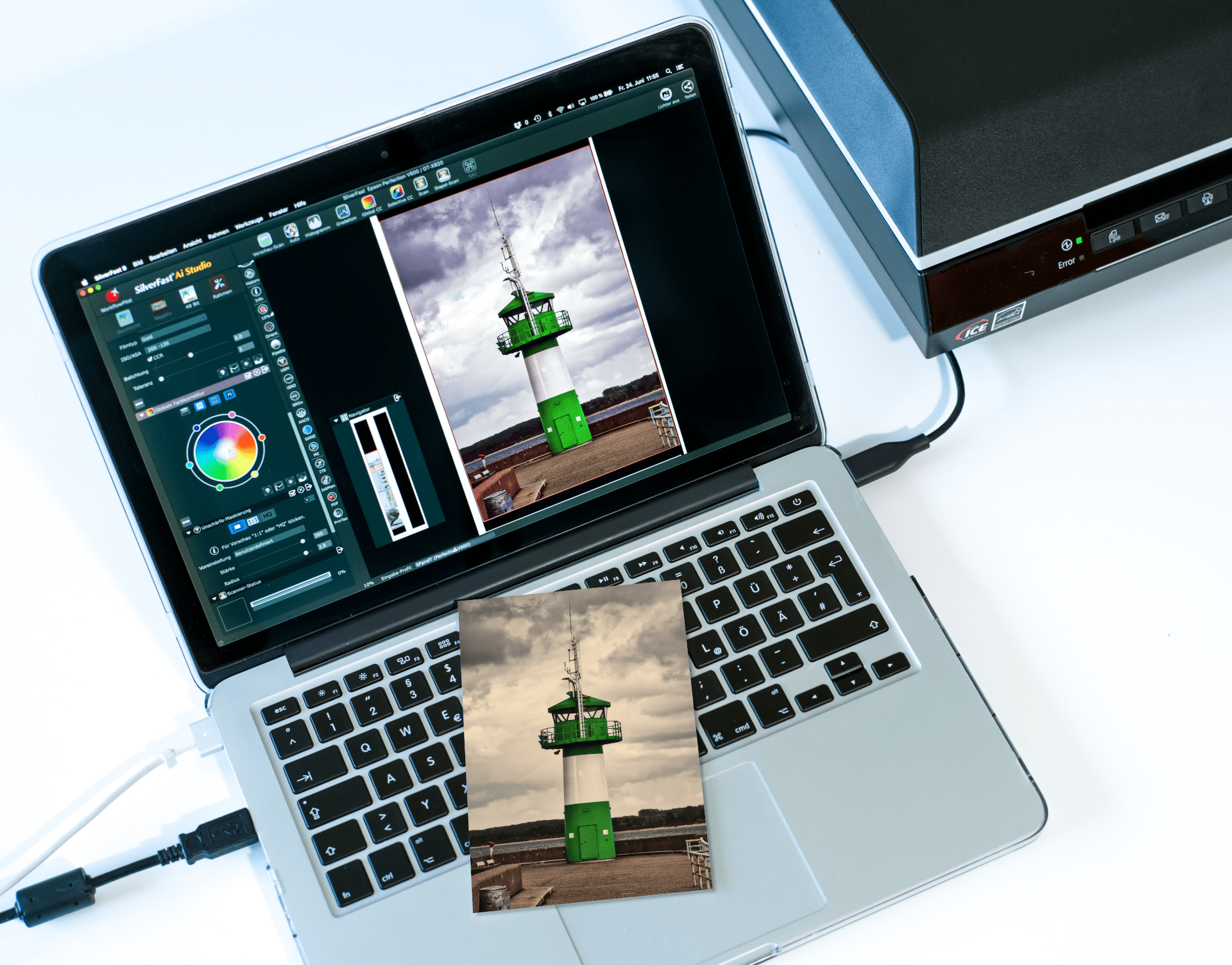
After using the software for 4 – 5 months, I’ve gone to love SilverFast and the whole entire workflow. […] The reason why I like SilverFast: The workflow is super super fast.
Photo prints, polaroids and other elements of instant photography enjoy widespread popularity even in today’s digital world. Nowadays, it’s quite common that someone has at one point or another put together a photo album, pinned a photo to a poster board or created a photo collage. Unlike analogue photography, photo prints have never really gone out of style.
Even in this age of digital photography, the presence of photo printing machines in drug stores and supermarkets gives us a clear sign that photo prints are just as important as ever. Photos exist to be looked at and enjoyed and what better way to do that than with a photo print!
Download our demo software to get to know SilverFast without any obligation. Already convinced? Visit our Online Store to purchase SilverFast and to unlock the full version.
Buy SilverFast Download DemoInstant image photography has been enjoying a comeback for some time now. Since 2015, instant camera sales have significantly increased. On the one hand, the advantage of polaroid photos is evident: immediately printed photos are instantly accessible, enabling photographers to immediately share their photos with others. On the other hand, polaroid photos wear out rather quickly, edges become frayed, tears and creases occur, photos become unattractive.
Fortunately, photo digitalization is quite simple. Digitalization preserves image quality, keeping the image intact and providing access to countless copies of the original image. It is also possible to restore blown out and even scratched images and then print them out in their new form. Whether working with black & white or color images, it is amazing to witness, the high-quality restoration of decade-old photos. A small tip: family photos can be scanned to create a beautiful picture album, an absolute eyecatcher and always a great present.
Now, let’s take a look at what to keep an eye on, especially when dealing with the high-quality scanning of photos, instant camera images and other reflective originals.

Working with high resolution, especially when scanning photos, is not always necessary. Photos usually have a resolution between 150 dpi and 600 dpi. For an image equal in both size and detail, a resolution of 300 dpi is recommended. If you want to print your images later, just enter the desired output size and SilverFast will automatically calculate the optimal required scanner resolution.
When increasing image size, it makes little sense to significantly increase image resolution as well. This is due to the fact that in most cases all image details are already recognized with 300 dpi. A resolution of 600 dpi is only required now-and-again by the odd exception. Ultimately, a higher resolution does not always guarantee increased image detail. A higher resolution means that the software is able to calculate additional image points that are not present in the original image. This is called interpolation. Interpolation can in turn decrease the sharpness of an image and should thus be avoided.
An image with a relatively low resolution is advantageous because of its quick processing time and comparatively small data size. This allows for the quick and effective scanning of large image archives.
In most cases, the appropriate scan resolution for a photo print is of secondary importance and no challenge for the hardware. The necessary resolution can be reached by almost every scanner. But what is the key to high-quality scanning?
The complete Dynamic Range of reflective originals can be captured with a single scan. Multi-Exposure, a feature that increases the Dynamic Range of the scanner, is unnecessary for reflective photos and is thus not available in the SilverFast Software, while in reflective mode.
A color profile (ICC) helps scanners reproduce colors accurately. It plays the role of a translator, translating between scanner and output device. Due to SilverFast’s color management ability, scanned images remain consistent in quality regardless of output device.
Every SilverFast Version comes fully equipped with a generic color profile for your scanner. It is possible to undergo further fine-tuning with an individual profile. An IT8-Target is used with our IT8 Calibration process in SilverFast Ai Studio to generate an individual highly precise ICC-profile.
Photos exist to be looked at and enjoyed. However, photos often have to deal with a lot of wear and tear and are thus commonly subject to creasing, finger prints, tearing and pin holes. In addition, image color may be adversely affected by exposure to light, causing the image to fade. In the end, photo decay speed is determined by the quality of storage conditions.
Adaptive color restoration ACR helps with the quick and uncomplicated restoration of faded colors. ACR provides the user with easy to use one-lick automatic color restoration. Custom color intensity adjustment is also available via the color saturation slider. This slider also allows the user to transform a color image into black & white.
A scanned photo often begins its journey as a negative. The negative is then developed into a photo print. The photo print is then scanned. This journey often has a negative impact on the sharpness of the photo. The human eye perceives bright/dark edges, known as contrast edges (detail contrast), as sharpness. In SilverFast, it is possible to improve the sharpness of an image with the USM (Unsharp Masking) tool. The USM tool accentuates contrast edges without changing the colour saturation of the image itself. As a result, the image appears sharper thanks to a now richer detail contrast.
SilverFast’s Auto-Sharpness tool substantially simplifies the re-sharpening process. The Auto-Sharpness tool automatically sets an appropriate base-sharpness depending on the scanner’s resolution. With USM, professional sharpening is available with the click of a button. The resulting sharpness can then be adjusted according to the personal preference of the user. It is important that, when possible, the final adjustments take place in an image view of 100%. This is important because the effect of the USM tool is subject to the resolution of the image. A lack of sharpness is recognizable by washed out and blurry edges. Furthermore, image details, that lack a clear detail contrast to their respective environment, also tend to point to an unsharp image. Conversely, too much sharpness is noticeable with the appearance of doubled edges, which are often enveloped by a bright line.
Photos can change over time in a number of ways. SilverFast offers a variety of tools for the execution of all types of color correction procedures.
With only a few clicks of the mouse, the Neutral Pipette tool is able to eliminate the color cast of an image. To deal with color cast, simply select an area of the image supposed to be a neutral grey area. SilverFast then eliminates the color cast, basing its calculations on the selected point supposed to be a neutral grey point. SilverFast’s Neutral Pipette tool balances the image’s R(ed), G(reen) and B(lue) values and reestablishes a uniform color balance.
With the selective and global Color Correction tool, it is possible to adjust individual colors and even change the overall appearance of an entire image. Did the grass in the original image has a significantly wormer green? An issue easily resolved with the Selective Color Correction tool SCC. Are the colors of your sunset too cold? The Global Color Correction tool GCC solves this issue with ease.
When working with photo prints, it is common to come across defects caused by dust, scratches, creases, holes and fingerprints. However, this does not mean that these defects have to remain in the scanned image. Many scanners possess an infrared channel for the removal of dust and scratches. This infrared channel recognizes defects when working with transparent originals, such as slides and film strips. Infrared light is, however, incompatible with reflective originals, such as photo prints. This is due to the fact that infrared light is unable to penetrate the photo prints’ reflective material. But there is another way. SilverFast offers 2 tools for the effective removal of defects from photo prints: the software-based dust and scratch remove tool SRDx and the Clone Tool.
SRDx is a software based dust and scratch removal tool. In essence, an intelligent algorithm searches for image defects and then marks these for removal. The software is thus able to clearly distinguish defects from their respective environment. The correction algorithm then fills the damaged image area with elements of the surrounding non-damaged area. Of course from time to time, even the most intelligent algorithm makes mistakes. To compensate for this, masks are used to reduce the correction tool to the affected area. In addition, SilverFast Ai Studio comes equipped with an eraser tool that allows for quick and effective protection of image details originally classified as defect.
In SilverFast HDR Studio, users have access to the Clone-Tool. The Clone Tool is effective when working with significantly damaged image areas. The Clone Tool transfers image data from non-damaged areas into damaged areas and replaces the damaged data. It is thus possible to restore significantly damaged images that even SRDx was unable to fix. Such major defects include deep creases, finger prints and pin holes.
In general, photos can be scanned using SilverFast SE, SE Pus and Ai Studio. In a nutshell, SilverFast SE Plus contains more functions than SE, while SilverFast Ai Studio offers more functions than SE Plus. For example, Ai Studio’s IT8 Calibration provides the user with a practical one-click-solution for color accurate reproductions.
For those interested in the printing of finished images, we recommend either SE Plus or Ai Studio because both versions can be upgraded to incorporate Printer Calibration. Printer calibration coupled together with a calibrated monitor provides users with a color calibrated workflow at an affordable price.
When scan editing and image editing take place separate from one another, we recommend our SilverFast Archive Suite (Ai Studio + HDR Studio). The Clone-Tool stamp tool is then also available in the Archive Suite.
Download our demo software to get to know SilverFast without any obligation. Already convinced? Visit our Online Store to purchase SilverFast and to unlock the full version.
Buy SilverFast Download Demo
After using the software for 4 – 5 months, I’ve gone to love SilverFast and the whole entire workflow. […] The reason why I like SilverFast: The workflow is super super fast.

Every photographer who has slides, negatives and prints to scan needs this software.
Individually adjusted to each scanner model, SilverFast brings out the maximum quality from any device and clearly exceeds the results of the manufacturers’ software.
The Archive Suite is a package consisting of color managed scanner software and imaging software. Scan and archive your images today, optimize and process them tomorrow.
LaserSoft Imaging is also known as flexible software engineer for tailor-made business solutions. SilverFast is a valuable part in many specialized business applications.